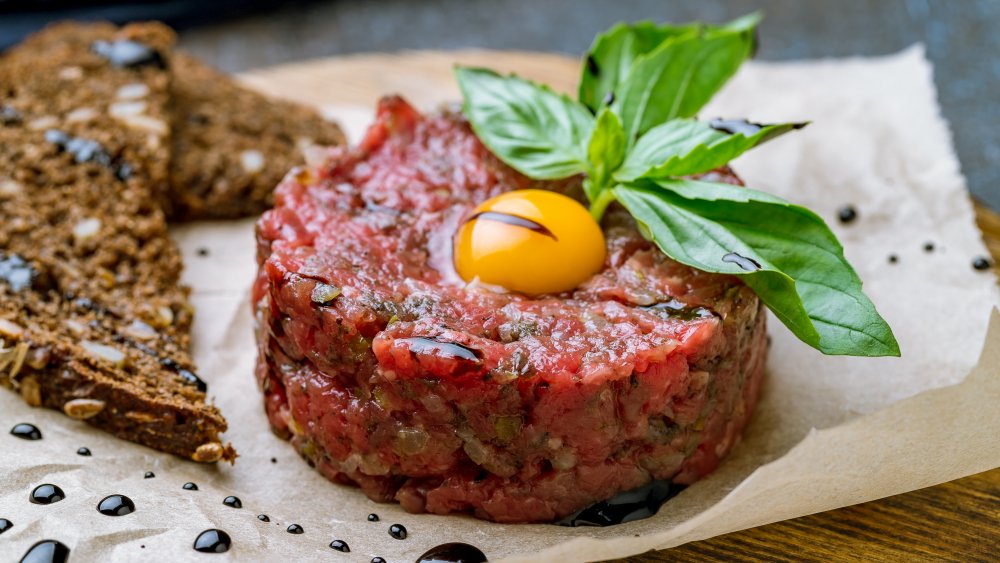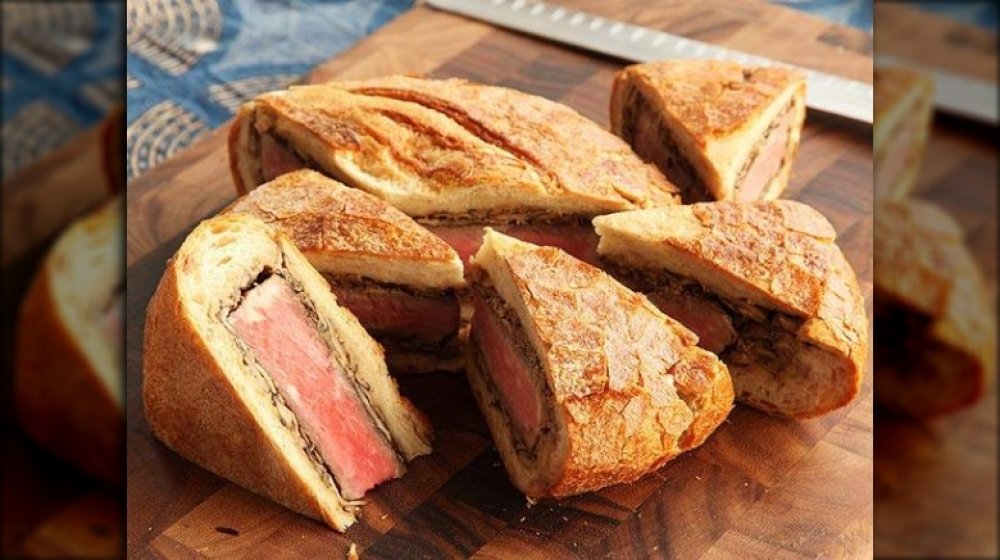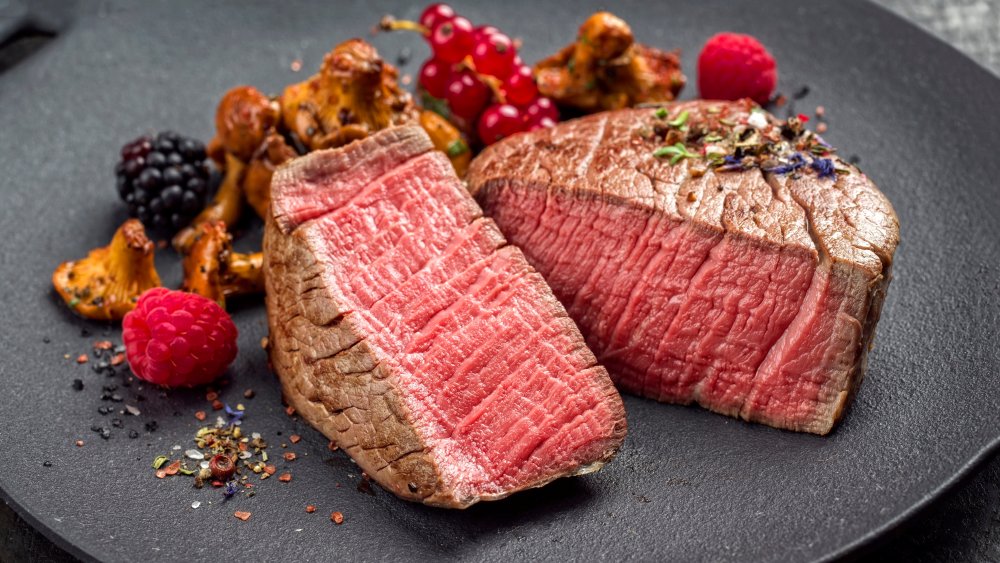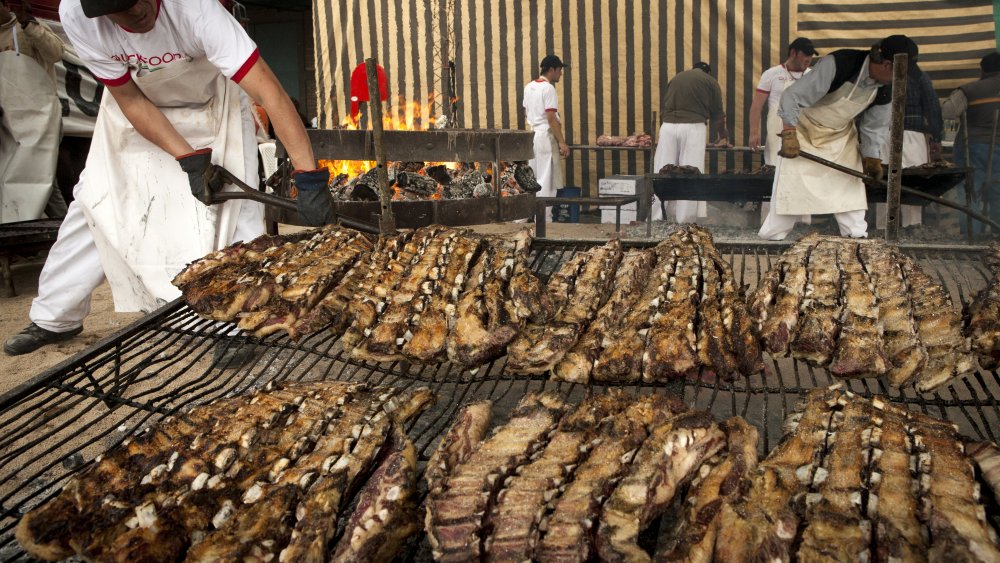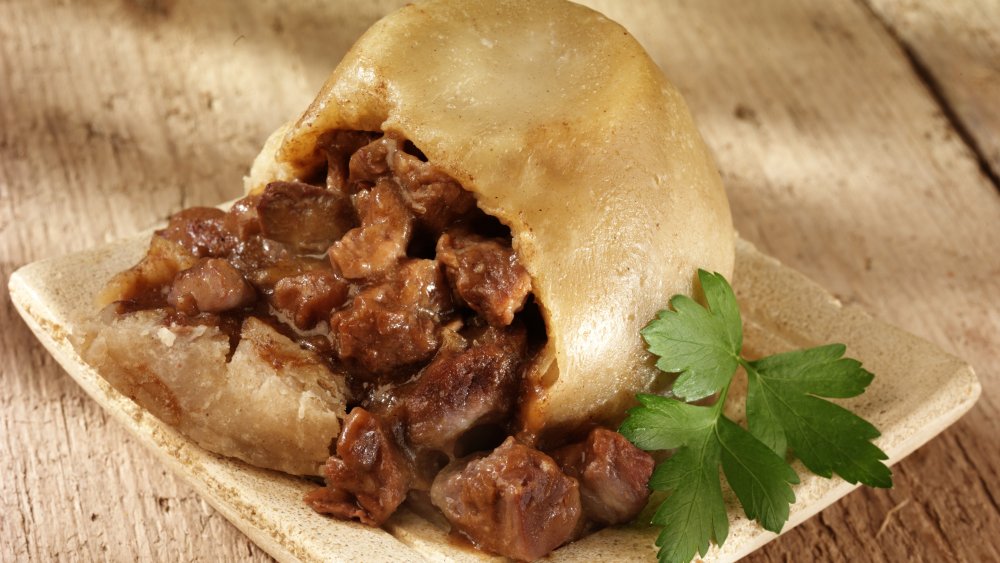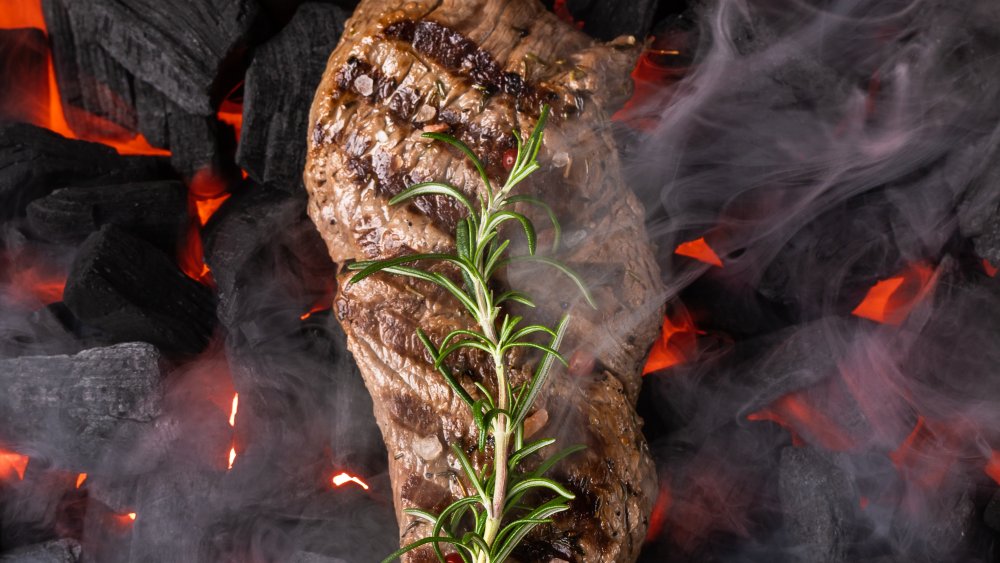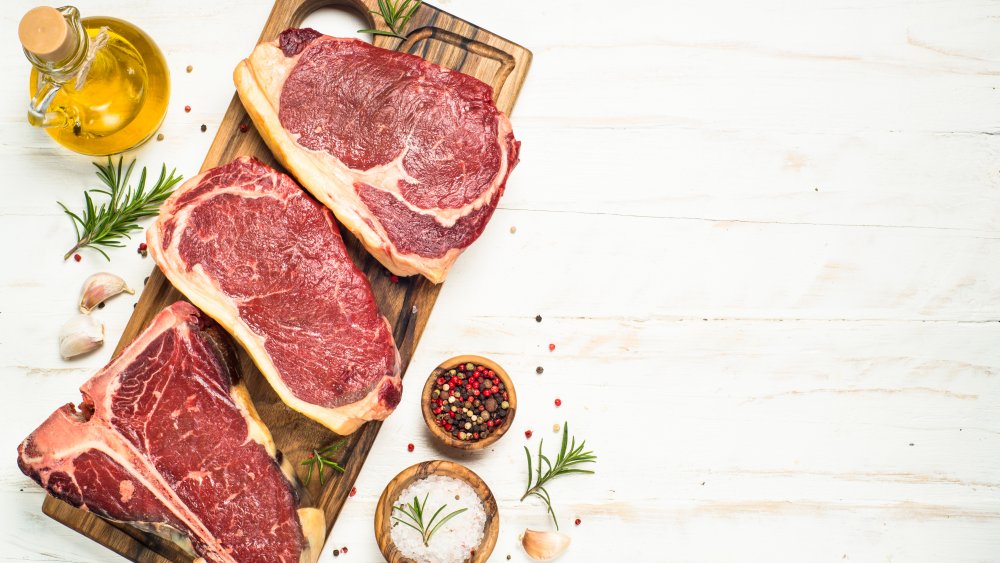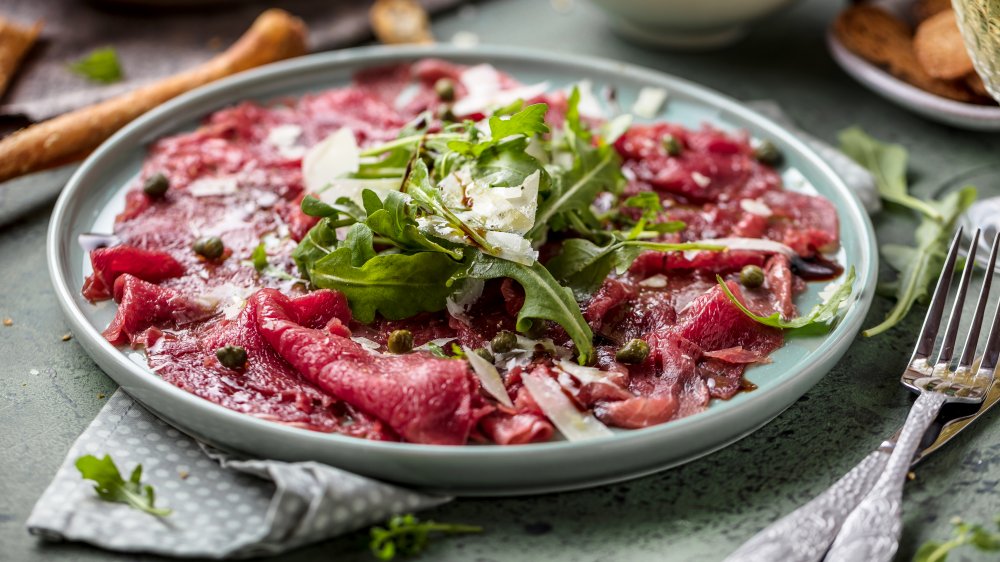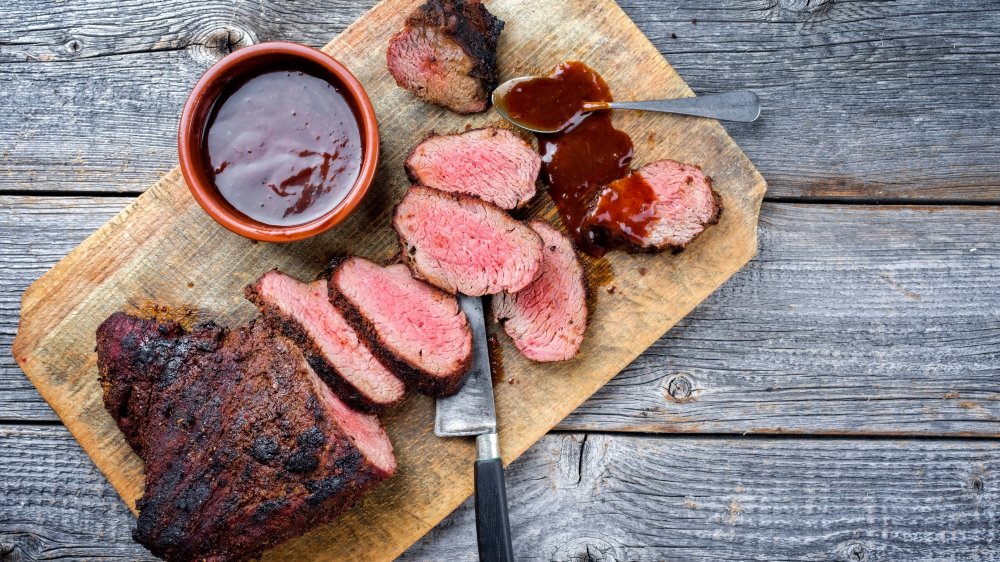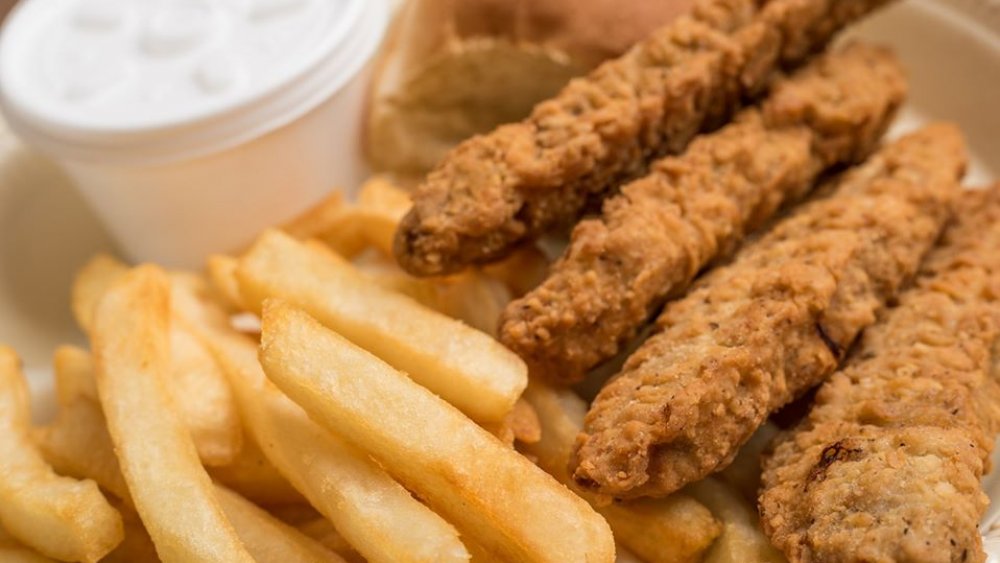The Weirdest Ways People Around The World Cook Steak
When it comes to all the different ways we can prepare some of our favorite foods, steak is pretty straightforward. Throw it on the grill, cook until it's as done as you want, and serve it up. There's usually minimal seasoning involved, not too much in the way of complicated prep or presentation, because that? That takes away from the fact that you're enjoying a brilliant steak, right?
That's not the case everywhere, though, and there are plenty of places around the world that have unique, odd, and just as delicious ways of preparing, cooking, and serving steak. In some cases, you don't even have to face that dreaded question: "How do you want your steak? Rare? Medium? Well-done?"
Will you want to try some of these? Probably! Will you want to try all of these? Maybe! There's only one way to find out: Check out these weird and wonderful ways that people around the world have of enjoying their steaks.
Steak tartare
We'll say this right upfront: You're probably not going to want to try steak tartare prepared in the super-traditional way. According to French Country Food, the story goes that the dish originated with the Mongolian warriors of Attila the Hun, who tenderized the raw meat they ate by putting it between their own undercarriages and their horse's back and riding all day long.
Doesn't sound sanitary, does it? It wouldn't be, and there's good news: That might be a myth, as there's no actual historical record suggesting that Mongolians actually did this.
What likely happened was a slow evolution from ancient dish to the modern bit of loveliness that made its way west via the Tartars and ended up in Russia, then Germany. Over the years, it's continued to evolve into a dish that's made from raw beef that's been cubed or coarsely ground, seasoned with extras like capers, onion, parsley, and Worcestershire sauce, then formed into a patty that's shaped into a dome. Once it reached Italy, an extra touch was added: a raw egg yolk on top. Yum? Maybe — it might be an acquired taste, but you never know if you'll like it until you try it!
Shooter's sandwich with steak
The shooter's sandwich might seem like the most questionably named sandwich of the 21st century, but it actually goes back to Edwardian England, or the very early 1900s. The idea was that it was a filling meal that could be easily wrapped and packed into a saddle bag for taking out to eat while hunting — hence, the name (via Serious Eats).
Is this something you're going to want to try? In its original form, absolutely.
It's somehow both simple and complicated: There's not much to it, but it'll take some planning. Start with a nice, crusty loaf of bread and a ribeye or two, slice off the top of the loaf, and hollow out the bread so it'll fit the steaks once they're cooked. Fill the bottom with cooked mushrooms and onions, then add your first cooked steak. Add another layer of mushroom and onions, then a second ribeye, and then? Smear some spicy mustard or horseradish on the underside of the loaf hunk you lopped off, put it back on your loaf, and wrap it as tightly as you can in parchment paper.
Put the whole thing under something heavy, and just leave it overnight. According to The Guardian, you shouldn't refrigerate it ... which makes sense for something that came out of Edwardian England. The following day, you'll have a steak-and-mushroom sandwich that you can cut like a cake and eat without making a mess. Brilliant? Absolutely.
Chateaubriand steak
Chateaubriand is one of those menu items that you might see at a super fancy French restaurant, but what is it?
According to The Daily Meal, it's a steak dish named for the French aristocrat Francois-Rene de Chateaubriand. (In case you'd like a little history, Britannica says that he's also notable for being one of the earliest French Romantic writers, and was a major figure in French literature throughout the early 1800s.)
Chateaubriand was frequently at odds with the powers that be, and he was often destitute — perhaps one reason that he came up with the method for cooking low-quality steaks that he'd give his name to. The Chateaubriand is basically a cut of boneless beef wrapped inside a few low-quality steaks (often the off-cuts from the filet), then cooked. The method helps make sure that inner steak remains juicy and delicious, and those outer steaks? They're typically discarded after cooking.
We know, we cringed a bit at that too. At the very least, hook up your puppers if you're not going to bring those steaks to the table.
The final dish is usually served with potatoes and a sauce made from stock, white wine, butter, tarragon, and shallots. Strange and decadent? For sure.
Asado steak
Argentina's traditional asado is definitely not the same as barbecue — and suggesting it is will just as definitely get you in trouble with any Argentinian within earshot, says The Real Argentina.
So, what is it? It starts with simplicity and a cast-iron grill called a parrilla (which is basically an adjustable grill). The fire comes from dry wood and charcoal, and getting it started? Briquettes are a no-no — instead, pine cones are traditionally used. From there, the flames are raked into glowing embers, and here's the trick: The hottest coals are kept to the side because a true asador doesn't want the dripping fat to hit them and smoke. That smoke can completely ruin the flavor profile. Instead, the steaks — often short rib, flank, and skirt — are cooked low and slow, and this is one case where extremely well-done isn't extreme, it's the desired level of doneness.
Toward the end of the cooking process, there are usually other things added to the parrilla: offal, sweetbreads, intestines, and kidneys, followed by blood sausage and discs of cheese. Sometimes it's all served with some salad, but that's absolutely not necessary. More often, it's meat, meat, and more meat, with steak and cuts that make sure nothing goes to waste, finished off with a nice Malbec. But whatever you do, just don't call it barbecue.
Steak and kidney pudding
"Pudding" can mean a few different things, and in this case, we're talking about the kind of pudding that the Cambridge Dictionary defines as "a hot dish made with pastry or flour that contains or is eaten with meat." Think of it as sort of a free-standing pot pie — it's a favorite dish in the UK, and it can be filled with a lot of different things. When it comes to popular versions, though, you don't get much more popular — or traditional — than steak and kidney pudding.
Kidney? Absolutely. According to The Telegraph, it goes back to the mid-1800s, and that was a time when many people were careful to make sure they didn't waste anything that could be turned into a hearty meal. (This idea of the pudding goes back even further, at least to the 17th century.)
Nigella Lawson says that it's easier than you think. There's the suet-based crust, and the filling is traditionally made with stewing steak, kidneys, mushrooms, onions, oyster sauce, and stout, because everything is better with a bit of beer.
Dirty steak
This weird one comes right from the good ol' US of A, and it's called dirty steak. No, you're not dropping it on the ground first, but ... in a way, that's kind of the idea.
You grill a dirty steak by by throwing it right on the coals. According to Epicurious, former president Dwight D. Eisenhower swore by this cooking method, particularly when the steak was a New York strip, and it was covered in salt and pepper before being thrown right on the coals.
According to The New York Times, the steak in this recipe doesn't burn, chars nicely, and doesn't get all questionably ashy. The coals are incredibly hot — between 800 and 1000 degrees Fahrenheit — so the steak cooks very quickly and very evenly without the flaming flare-ups that can happen when you use the grill's grate.
There are a couple things you'll need to know before trying it, though. A dry rub is absolutely necessary, as it not only protects the meat, but it also caramelizes into a crust that's nothing short of spectacular. Secondly, you'll have to opt for natural chunk charcoal, not briquettes. You don't want any funky chemicals touching your meat, right? Go on, give it a try.
Ultra-fermented steak, mold and all
There's a few bits of common knowledge that this steak-cooking method will just completely ignore. One is that there's a sweet spot of how long steak should be aged, and the other is that mold on steak is bad. But moldy steak is a real thing that some people eat.
According to The Guardian, there's an ultra-trendy way of aging steak that's taking it well beyond the standard 28 days or even the 42 days of the super-delicious stuff. Steakhouses in cities like Dallas, New York City, and London are doing what some call "extreme aging," while others are calling it "controlled decomposition," which ... just doesn't have the same ring to it. And they're doing some serious aging, letting their steaks sit for as long as 459 days.
Chef James Cross says that once steaks pass the 90-day mark, they start to develop deep, complex umami flavors, with hints of flavors like blue cheese and truffle buried in those the meat. These new flavors develop when enzymes in the meat start breaking down molecules that then release new flavors. And yes, part of that comes from the mold that develops on the fat. Blue cheese is mold, after all, and the 199-day aged steak is described with words like "ripe cheesiness," and "chemical astringency." Yum?
Carpaccio steak
Carpaccio is an Italian dish, and it's a little unique in that we know exactly where it was invented: Harry's Bar in Venice, according to Great Italian Chefs. It's only been around since the 1950s, and it's been popular in Italy since it first started showing up on menus.
It's also incredibly easy to make. It's essentially a piece of steak sliced super-thin and served raw. Usually, there's a bit of vinaigrette drizzled over it, and it's commonly served with sun-dried tomatoes and a salad, making it pretty perfect for hot summer days.
Now, the big question: Is it safe? We hear all kinds of reasons why we should be cautious of undercooked meat, so raw meat? The idea of eating that is super weird. But yes, says The Cookful, it's safe, as long as you follow some simple rules. Get the freshest piece of meat that you can, preferably from a butcher who knows you're going to be eating it raw. Prepare and eat it the same day, and don't save anything for leftovers. Since you're slicing it from one single piece of meat, there's little chance of contamination. Just remember that freshness is key.
Steak aged with a Japanese fungus
We all know that aging just makes steak better, but aging takes time, right? Here's the weird thing: Japanese chefs have known about a shortcut for a long time.
It's called koji, or more scientifically, it's Aspergillus oryzae. It's a fungus, and it's entirely possible to slather it onto a steak and speed up the dry-aging process ... by a lot. According to Popular Science, it's possible to dry-age a steak in just 48 hours with help from this handy little fungus.
Koji is basically known as the national mold of Japan. In fact, the same thing that's used to make miso, soy sauce, and some types of sake. While the science behind it isn't 100 percent understood, we do know that when koji is put onto a steak, the enzymes it releases actually tenderize the steak in an almost shockingly fast way. After just two days, a fresh steak will be just as tender and flavorful as one that's been aged for 45 days.
Pretty brilliant, right? It gets better. Koji is widely available online, and you can definitely buy it and age your own steaks at home. Have a special occasion coming up? Try this super-trendy yet old-school way of aging steak, and take that special meal to a whole new level.
Finger steaks
If there's one thing that steak is not, it's a finger food ... right?
Not so fast. Head into Idaho, and you'll find a pretty incredible regional delicacy called finger steaks. According to The Spokesman-Review, finger steaks were the brainchild of the chef at Milo's Tavern in Boise. It was the 1950s, and the owner — presumably looking for something to set them apart from all the rest — came up with the idea of cutting steak into strips between two and three inches long and about half an inch thick. They were then breaded and deep-fried, and that's it.
Finger steaks became associated with a certain type of establishment — specifically, the seedy dive bar. Still, we all know that these are the places where you can get some of the best food in the world, right?
You can try to make finger steaks at home, but those in the know say that they're hard to get right, even when you start with an overnight soak in buttermilk and a dusting of cornstarch to make the batter stick to the steak. You can make these "fries" with tempura batter and side of cocktail sauce for sure, but for the real thing? Only Idaho does it best.

